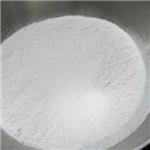Rosiglitazone is a type of thiazolidinedione antidiabetics. Thiazolidinedione are agonists for peroxisome-proliferator–activated receptor γ (PPAR-γ). PPAR-γ receptors are ligand-activated nuclear transcription factors that modulate gene expression, lowering blood glucose primarily by increasing insulin sensitivity in peripheral tissues.
Rosiglitazone is widely used to lower blood glucose levels in patients with type 2 diabetes mellitus. Rosiglitazone functionalizes by makes the cells of the body more sensitive to the naturally produced insulin in body. It shouldn’t be used if the patient is injecting or inhaling insulin. Using rosiglitazone with insulin could increase the risk of heart failure. Patients having heart failure with symptoms or moderate to severe heart failure should not use Rosiglitazone.
[1] http://www.nejm.org/doi/full/10.1056/NEJMoa072761#t=article
[2] http://circ.ahajournals.org/content/128/8/785
[3] https://www.drugs.com/cdi/rosiglitazone.html
A potent and selective PPARγ agonist.
Rosiglitazone is an insulin sensitizer; binds to peroxisome proliferator activated receptor gamma (PPAR- γ).
Rosiglitazone is approved for use as monotherapy
and in conjunction with metformin, though it is sometimes
combined with a sulfonylurea or insulin. It is usually
taken once or twice a day with or without food.
Rosiglitazone may cause a modest increase in lowdensity
lipoprotein and triglyceride concentrations, but
it is unclear whether this effect has any clinical significance
or persists in the long term.
ChEBI: Rosiglitazone is an aminopyridine and a member of thiazolidinediones. It has a role as an insulin-sensitizing drug, a ferroptosis inhibitor and an EC 6.2.1.3 (long-chain-fatty-acid--CoA ligase) inhibitor. It is a conjugate acid of a rosiglitazone(1-).
Avandia (GlaxoSmithKline).
Rosiglitazone is 5-[4-[2-(N-methyl-N-(2-pyridyl)amino)ethoxy]benzyl]thiazolidine-2,4-dione, and is availableas the maleate salt in tablets containing the drug alone(Avandia) or in combination products with metformin(Avandamet) or with glimepiride (Avandaryl). The2-aminopyridine moiety allows for salt formation; the marketedformulations contain the 1:1 salt with maleic acid, inwhich the pyridine nitrogen accepts a proton, forming the2-aminopyridinium species.
Rosiglitazone, (±)-5-[[4-[2-(methyl-2-pyridinylamino)ethoxy]phenyl]methyl]-2,4-thiazolidinedione(Avandia), is a white to off-white solid with pKavalues of 6.8 and 6.1. Rosiglitazone is readily soluble inethanol and a buffered aqueous solution with pH of 2.3; solubilitydecreases with increasing pH in the physiologicalrange. The molecule has a single chiral center and is presentas a racemate. Even so, the enantiomers are functionally indistinguishablebecause of rapid interconversion.
rosiglitazone is a potent agonist of peroxisome proliferator-activated receptor γ (pparγ), a subfamily of the nuclear-receptor superfamily which is predominately expressed in adipose tissue and regulates gene expression responding to ligand binding. belonging to the thiazolidinedione (tzd) class, rosiglitazone, like other tzd members, binds to pparγ dna as heterodimers and activate transcription of various metabolic regulators involved in the differentiation of stem cells into adipocytes and increased expression of genes regulating the metabolism of glucose and lipid. rosiglitazone is used to treat patients with type ii diabetes mellitus for its strong ability to improve insulin sensitization through its effects either on fatty acid uptake and storage in adipose tissue or on adiokines.peter j. cox, david a. ryan, frank j. hollis, ann-marie harris, ann k. miller, marika vousden and hugh cowley. absorption, disposition, and metabolism of rosiglitazone, a potent thiazolidinedione insulin sensitizer, in humans. drug metabolism and disposition 2000; 28 (7): 772-780adie vilioen and alan sinclair. safety and efficacy of rosiglitazone in the elderly diabetic patient. vascular health and risk management 2009: 5 389-395
Rosiglitazone is a potent agonist for PPARγ with an EC50 of 43 nM for the human receptor. It is antidiabetic, working as an insulin sensitizer by binding to the PPARγ receptors in fat cells and making the cells more responsive to insulin.
Although rosiglitazone is extensively biotransformed—playing the major role in both transformations, and some involvementof CYP2C9.21,47 The sulfate conjugate M10 is thepredominant circulating metabolite by 4-hour postdose. Theextraordinarily high plasma protein binding of this metabolite(and the N-demethylated sulfate conjugate M4) in humans accountsfor the lengthy residence time of the radioactivity in thebody, despite the relatively short pharmacokinetic half-life(4–4.5 hours) of rosiglitazone itself.



